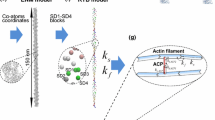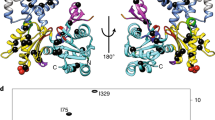Abstract
In this paper, the elastic properties of monomeric actin (G-actin) and the trimer nucleus (G-actin trimer) in different states of nucleotide binding are estimated using steered molecular dynamic (SMD) simulations. Three nucleotide binding states are considered: ADP- and ATP-bound actin and nucleotide-free actin assemblies. Our results show that nucleotide binding and the corresponding changes in structure have significant effects on the mechanical behaviors of actin assemblies. Simulations reveal that the deformation behavior of G-actin monomers is generally elastic up to engineering strains of 16 and 40% in the tension and shear tests, respectively. In addition, the G-actin trimers react linearly up to strains of 18%. The computed persistence lengths for G-actin monomers and trimers are in the range of 8–20 μm, which are consistent with earlier experimental results. Our atomistic simulation results also reveal that formation and rupture of hydrogen bonds between actin nucleotide binding site and its nucleotide have significant role in response of actin assemblies to loading. This study provides more information about the relationship of actin nucleotide binding and mechanical properties of cytoskeleton.










Similar content being viewed by others
References
Ackbarow, T., and M. Buehler. Superelasticity, energy dissipation and strain hardening of vimentin coiled-coil intermediate filaments: atomistic and continuum studies. J. Mater. Sci. 42:8771–8787, 2007.
Allen, M. P., and D. J. Tildesley. Computer Simulation of Liquids. New York: Oxford University Press, 1987.
Boal, D. Mechanics of the Cell. New York: Cambridge University Press, 2002.
Chu, J.-W., and G. A. Voth. Allostery of actin filaments: molecular dynamics simulations and coarse-grained analysis. PNAS 102:13111–13116, 2005.
Chu, J.-W., and G. A. Voth. Coarse-grained modeling of the actin filament derived from atomistic-scale simulations. Biophys. J. 90:1572–1582, 2006.
Civelekoglu, G., and L. Edelstein-Keshet. Modelling the dynamics of F-actin in the cell. Bull. Math. Biol. 56:587–616, 1994.
Gardel, M. L., F. Nakamura, J. H. Hartwig, J. C. Crocker, T. P. Stossel, and D. A. Weitz. Prestressed F-actin networks cross-linked by hinged filamins replicate mechanical properties of cells. PNAS 103:1762–1767, 2006.
Gardel, M. L., J. H. Shin, F. C. MacKintosh, L. Mahadevan, P. Matsudaira, and D. A. Weitz. Elastic behavior of cross-linked and bundled actin networks. Science 304:1301–1305, 2004.
Graceffa, P., and R. Dominguez. Crystal structure of monomeric actin in the ATP state: structural basis of nucleotide-dependent actin dynamics. J. Biol. Chem. 278:34172–34180, 2003.
Grubmüller, H., H. Heller, A. Windemuth, and K. Schulten. Generalized verlet algorithm for efficient molecular dynamics simulations with long-range interactions. Mol. Simul. 6:121–142, 1991.
Holmes, K. C., D. Popp, W. Gebhard, and W. Kabsch. Atomic model of the actin filament. Nature 347:44–49, 1990.
Humphrey, W., A. Dalke, and K. Schulten. VMD: visual molecular dynamics. J. Mol. Graph. 14:33–38, 1996.
Huxley, H. E., A. Stewarta, H. Sosaa, and T. Irvinga. X-ray diffraction measurements of the extensibility of actin and myosin filaments in contracting muscle. Biophys. J. 67:2411–2421, 1994.
Isambert, H., P. Venier, A. Maggs, A. Fattoum, R. Kassab, D. Pantaloni, and M. Carlier. Flexibility of actin filaments derived from thermal fluctuations. Effect of bound nucleotide, phalloidin, and muscle regulatory proteins. J. Biol. Chem. 270:11437–11444, 1995.
Isralewitz, B., M. Gao, and K. Schulten. Steered molecular dynamics and mechanical functions of proteins. Curr. Opin. Struct. Biol. 11:224–230, 2001.
Keten, S., and M. J. Buehler. Large deformation and fracture mechanics of a beta-helical protein nanotube: atomistic and continuum modeling. Comput. Meth. Appl. Mech. Eng. 197:3203–3214, 2008.
Kojima, H., A. Ishijima, and T. Yanagida. Direct measurement of stiffness of single actin filaments with and without tropomyosin by in vitro nanomanipulation. PNAS 91:12962–12966, 1994.
Lee, E., M. Gao, N. Pinotsis, M. Wilmanns, and K. Schulten. Mechanical strength of the titin Z1Z2-telethonin complex. Structure 14:497–509, 2006.
Lewin, B., L. Cassimeris, V. R. Lingappa, and L. Cassimeris. Cells. Sudbury, MA: Jones & Bartlett Publishers, 2006, 863 pp.
Lodish, H., A. Berk, P. Matsudaira, C. A. Kaiser, M. Krieger, M. P. Scott, L. Zipursky, and J. Darnell. Molecular Cell Biology. New York: W.H. Freeman & Company, 2005, 973 pp.
MacKerell, A. D., D. Bashford, M. Bellott, R. L. Dunbrack, J. D. Evanseck, M. J. Field, S. Fischer, J. Gao, H. Guo, S. Ha, D. Joseph-McCarthy, L. Kuchnir, K. Kuczera, F. T. K. Lau, C. Mattos, S. Michnick, T. Ngo, D. T. Nguyen, B. Prodhom, W. E. Reiher, B. Roux, M. Schlenkrich, J. C. Smith, R. Stote, J. Straub, M. Watanabe, J. Wiorkiewicz-Kuczera, D. Yin, and M. Karplus. All-atom empirical potential for molecular modeling and dynamics studies of proteins. J. Phys. Chem. B 102:3586–3616, 1998.
Minehardt, T. J., P. A. Kollman, R. Cooke, and E. Pate. The open nucleotide pocket of the profilin/actin X-ray structure is unstable and closes in the absence of profilin. Biophys. J. 90:2445–2449, 2006.
Mofrad, M. R. K. Rheology of the cytoskeleton. Annu. Rev. Fluid Mech. 41:433–453, 2009.
Mofrad, M. R. K., and R. D. Kamm. Introduction, with the biological basis for cell mechanics. In: Cytoskeletal Mechanics. Cambridge: Cambridge University Press, 2006, pp. 1–17.
Nelson, P. Biological Physics. New York: W. H. Freeman, 2004.
Oda, T., M. Iwasa, T. Aihara, Y. Maeda, and A. Narita. The nature of the globular- to fibrous-actin transition. Nature 457:441–445, 2009.
Otterbein, L. R., P. Graceffa, and R. Dominguez. The crystal structure of uncomplexed actin in the ADP state. Science 293:708–711, 2001.
Palmer, A., T. G. Mason, J. Xu, S. C. Kuo, and D. Wirtz. Diffusing wave spectroscopy microrheology of actin filament networks. Biophys. J. 76:1063–1071, 1999.
Phillips, J. C., R. Braun, W. Wang, J. Gumbart, E. Tajkhorshid, E. Villa, C. Chipot, R. D. Skeel, L. Kalé, and K. Schulten. Scalable molecular dynamics with NAMD. J. Comput. Chem. 26:1781–1802, 2005.
Popov, E. P. Engineering Mechanics of Solids. Upper Saddle River, NJ: Prentice Hall, 1998.
Sadd, M. H. Elasticity: Theory, Applications, and Numerics. St Louis, MO: Academic Press, 2004.
Schlick, T., R. D. Skeel, A. T. Brunger, L. V. Kale, J. A. Board, J. Hermans, and K. Schulten. Algorithmic challenges in computational molecular biophysics. J. Comput. Phys. 151:9–48, 1999.
Sotomayor, M., and K. Schulten. Single-molecule experiments in vitro and in silico. Science 316:1144–1148, 2007.
Stuart, S. J., A. B. Tutein, and J. A. Harrison. A reactive potential for hydrocarbons with intermolecular interactions. J. Chem. Phys. 112:6472–6486, 2000.
Timoshenko, S. Theory of Elasticity. New York: McGraw-Hill Companies, 1970.
Tuszynski, J. A., J. A. Brown, and D. Sept. Models of the collective behavior of proteins in cells: tubulin, actin and motor proteins. J. Biol. Phys. 29:401–428, 2003.
van Duin, A. C. T., S. Dasgupta, F. Lorant, and W. A. Goddard. ReaxFF: a reactive force field for hydrocarbons. J. Phys. Chem. A 105:9396–9409, 2001.
Vikhorev, P. G., N. N. Vikhoreva, and A. Månsson. Bending flexibility of actin filaments during motor-induced sliding. Biophys. J. 95:5809–5819, 2008.
Wakabayashi, K., Y. Sugimoto, H. Tanaka, Y. Ueno, Y. Takezawa, and Y. Amemiya. X-ray diffraction evidence for the extensibility of actin and myosin filaments during muscle contraction. Biophys. J. 67:2422–2435, 1994.
Wang, Y. L. Analysis of microtubule curvature. In: Cell Mechanics, edited by Y. L. Wang and D. E. Discher. Academic Press, 2007, p. 496.
Zheng, X., K. Diraviyam, and D. Sept. Nucleotide effects on the structure and dynamics of actin. Biophys. J. 93:1277–1283, 2007.
Acknowledgment
The authors thank A. R. Khoei for his valuable support and M. J. Abdolhosseini Qomi for helpful discussions.
Author information
Authors and Affiliations
Corresponding author
Additional information
Associate Editor Muhammad Zaman oversaw the review of this article.
Rights and permissions
About this article
Cite this article
Ghodsi, H., Kazemi, M.T. Elastic Properties of Actin Assemblies in Different States of Nucleotide Binding. Cel. Mol. Bioeng. 5, 1–13 (2012). https://doi.org/10.1007/s12195-011-0181-z
Received:
Accepted:
Published:
Issue Date:
DOI: https://doi.org/10.1007/s12195-011-0181-z




